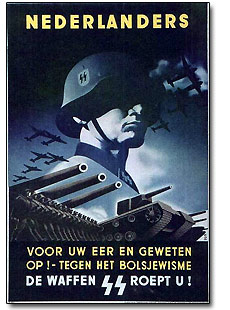Waffen SS (Armed SS) Brief History, page 2
Multinational SS Viking Division, Estonian 20.Waffen-Grenadier-Division der SS (estnische Nr.1)
Himmler, wishing to expand the Waffen-SS, advocated the idea of SS controlled foreign legions. In late 1940, the creation of a multinational SS division, the Wiking, was authorized. Command of the division was given to SS-Brigadeführer Felix Steiner. Steiner immersed himself in the organization of the volunteer division, soon becoming a strong advocate for an increased number of foreign units. The Wiking was committed to combat several days after the launch of Operation Barbarossa, proving itself an impressive fighting unit.
Soon Danish, French, Azeri, Armenian, Belgian, Norwegian, Swedish, Finnish and Dutch Freiwilligen (volunteer) formations were committed to combat, gradually proving their worth. Hitler however, was hesitant to allow foreign volunteers to be formed into formations based on their ethnicity, preferring that they be absorbed into multinational divisions. Hitler feared that unless the foreign recruits were committed to the idea of a united Germany, then their reasons for fighting were suspect, and could damage the German cause. The Freiwilligen formations were to be commanded by German officers and NCOs.

SS Recruiting Poster
for Scandinavians
Beginning in 1942-43, several new formations were formed from Bosnians, Latvians, Estonians, and Ukrainians. Himmler ordered that new Waffen-SS units formed with men of non-Germanic ethnicity were to be designated Division der SS (or Division of the SS) rather than SS Division. In some of these cases, the wearing of the SS runes on the collar was forbidden, with several of these formations wearing national insignia instead.
All soldiers of non-German citizenship in these units had their rank prefix changed from SS to Waffen (e.g. a Latvian Hauptscharführer would be referred to as a Waffen-Hauptscharführer rather than SS-Hauptscharführer). An example of a Division der SS is the Estonian 20.Waffen-Grenadier-Division der SS (estnische Nr.1).
Among the more unusual units to exist in the Waffen SS was the British Free Corps, a unit composed of citizens of the British Commonwealth, was led by John Amery but never had a strength of more than 30 men at any given time. The American Free Corps or "George Washington Brigade" was also a tiny unit of English speaking SS men raised for propaganda purposes that consisted of no more than 5 members.
The most unusual unit within Waffen SS was the Bosnian Muslim Waffen SS (the "Hanjar Troopers") organized by Haj Mohammad Amin al-Husseini, the "Grand Mufti of Jerusalem," with Hitler's approval in 1943. The "Hanjar Troopers" comprised some 20,000 Moslem Bosnians and slaughtered 90 percent of the Jews in Bosnia.
The Grand Mufti's vicious anti-Semitic and pro-Nazi ideologies not only earned him a title "Hitler of Arab World" but also inspired a few young nationalists who became his ardent disciples and fans of Nazi ideology. One of them was his nephew whom the world has known as Yasser Arafat. Another one was Khayrallah Tulfah once jailed for four years for his pro-Nazi activities. In 1947, Khayrallah Tulfah gave a home to his sister's ten year old son, an orphan, who himself later became a strong believer in Nazi ideology. His name was Saddam Hussein.
The Grand Mufti was admired by Shah Reza Pahlavi, a nationalist general in Persia. Shah Reza was also a fan of Hitler's theories of racial supremacy. When he seized power in 1925, he even renamed his own country "Iran" (Iran means "Aryan" in Persian) shortly after Hitler's rise to power.
By the end of the World War II, around 60% of Waffen-SS members were non-German. While several volunteer units performed poorly in combat, the majority acquitted themselves well. French and Spanish SS volunteers, along with remnants of the 11.SS-Freiwilligen-Panzergrenadier-Division Nordland formed the final defense of the Reichstag in 1945.
After the surrender, many volunteers were tried and imprisoned by their countries. In several cases, volunteers were executed. Those volunteers from the Baltic states and Ukraine could at best look forward to years spent in the gulags. To avoid this, many ex-volunteers from these regions joined underground resistance groups of freedom fighters, such as Forest Brothers in Baltic states, which were engaged fighting the Soviets until the 1950s.
In the end, the Waffen-SS would total 38 combat divisions comprising over 950,000 men, and including a number of elite units. Their importance in the history of the Second World War cannot be overlooked. Their effectiveness as fighting units coupled with the atrocities that were committed make the Waffen-SS one of the most infamous military organizations in history.
WW2 Military Relic Hunting page